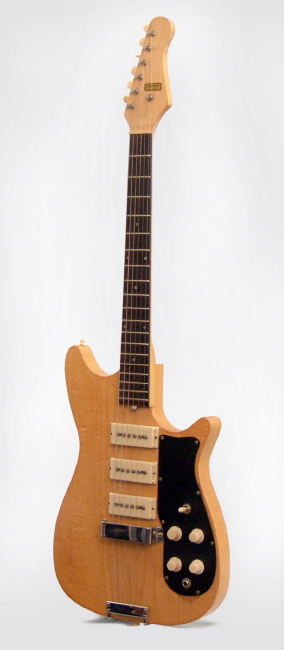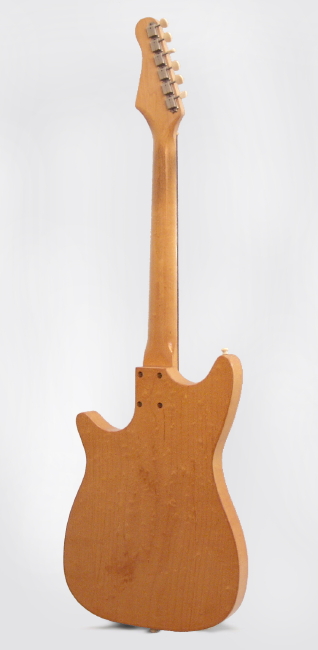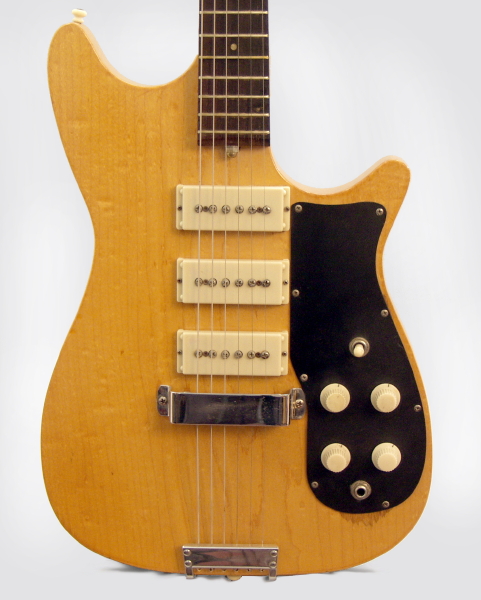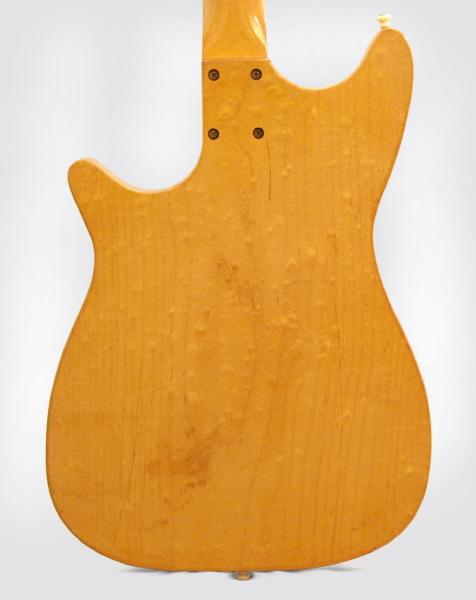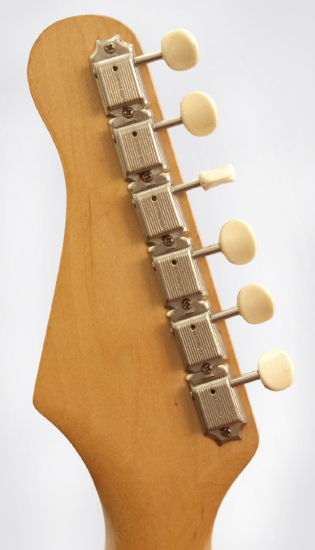Carvin 61-SGB Solid Body Electric Guitar (1961)
This item has been sold.
Item # 4006
Prices subject to change without notice.
Carvin 61-SGB Model Solid Body Electric Guitar (1961), made in Covina, California, natural finish, maple body and neck, rosewood fingerboard, original grey hard shell case.
An interesting historical piece, and a fine little guitar despite its rather homemade appearance! Carvin instruments are a product of the same Southern California spawning grounds as many of the great electric guitar lines of the 20th century; Fender, Rickenbacker, National, Bigsby, and Mosrite all emerged from the same general time and place.
The confluence of a lively, progressive hillbilly music scene, proximity to the entertainment colossus of Hollywood, and numerous untraditionally-minded craftsmen resulted in a radical re-thinking of the electric guitar, and the emergence of the solid body instrument as its ultimate form. While Carvin is not usually mentioned in connection with these other pioneers, the small California company was active from early on and is still experiencing ongoing success.
Carvin founder Lowell Kiesel moved his fledgling steel guitar-building operation from Nebraska to California around 1948, and by 1950 had changed the name from Kiesel to Carvin, which combined his two sons' names. (See our stock #2604 for an extremely rare and early Kiesel steel guitar). Carvin became famous for selling primarily electric instruments through mail order only, as well as being one of the few sources selling parts for do-it-yourself electric guitar tinkerers in the 50's. Carvin's best remembered products of the era are the spectacular sounding AP-6 pickups, the early favorite of Semie Moseley (among others) for his handmade guitars.
The Model 61-SGB was Carvin's top of the line solid body electric, newly re-styled this year into a more Fender-like shape after debuting in the late 1950's. This guitar is the second variation of the model, with the previously more eccentric body replaced by a kind of "flat Strat" profile. Carvin had for several years in the early 50's been selling Fender guitars through their mail-order catalog, and no doubt took notice of their growing popularity.
Not surprisingly, by 1958 Fenders were no longer listed by Carvin, and the home-grown SGB series became Carvin's flagship instruments. When this 61-SGB was built, it was the top of the Spanish guitar line, which also included electric basses, mandolins, and doublenecks. The company was extremely proud of these "butcher block" solid bodies, going so far as to disparage guitar makers who finished their instruments in fancy solid colors. Carvin's main sale items at the time were still steel guitars and amplifiers, and these Spanish guitars are relatively rare.
While crude-looking next to a Fender, this is a solidly-made guitar, and with three cream plastic AP-6 pickups, a 3-way switch, and individual tone and volume controls is quite powerful and versatile-sounding. These early Carvins have a rather 'homemade' aspect to them, but this is a good-playing and very fine-sounding guitar. These same pickups were used on Joe Maphis' and Larry Collins' Mosrite doublenecks, and the sound is pure Hollywood Hillbilly Heaven all the way.
Known mostly to vintage tone connoisseurs, the AP-6 is regarded as worthy of listing with the pre-war Rickenbacker horseshoe, the Fender Broadcaster pickups, and the Gibson PAF as one of the finest-sounding coils of wire ever wound, and is waiting to be rediscovered by a wider audience.
Overall length is 38 7/8 in. (98.7 cm.), 12 1/2 in. (31.8 cm.) wide at lower bout, and 1 1/2 in. (3.8 cm.) in depth, measured at side of rim. Scale length is 25 1/4 in. (641 mm.). Width of nut is 1 5/8 in. (41 mm.).
All original parts. Clear overspray added on body and back of neck. Plays well with three great-sounding AP-6 pickups. Generally Excellent Condition.
An interesting historical piece, and a fine little guitar despite its rather homemade appearance! Carvin instruments are a product of the same Southern California spawning grounds as many of the great electric guitar lines of the 20th century; Fender, Rickenbacker, National, Bigsby, and Mosrite all emerged from the same general time and place.
The confluence of a lively, progressive hillbilly music scene, proximity to the entertainment colossus of Hollywood, and numerous untraditionally-minded craftsmen resulted in a radical re-thinking of the electric guitar, and the emergence of the solid body instrument as its ultimate form. While Carvin is not usually mentioned in connection with these other pioneers, the small California company was active from early on and is still experiencing ongoing success.
Carvin founder Lowell Kiesel moved his fledgling steel guitar-building operation from Nebraska to California around 1948, and by 1950 had changed the name from Kiesel to Carvin, which combined his two sons' names. (See our stock #2604 for an extremely rare and early Kiesel steel guitar). Carvin became famous for selling primarily electric instruments through mail order only, as well as being one of the few sources selling parts for do-it-yourself electric guitar tinkerers in the 50's. Carvin's best remembered products of the era are the spectacular sounding AP-6 pickups, the early favorite of Semie Moseley (among others) for his handmade guitars.
The Model 61-SGB was Carvin's top of the line solid body electric, newly re-styled this year into a more Fender-like shape after debuting in the late 1950's. This guitar is the second variation of the model, with the previously more eccentric body replaced by a kind of "flat Strat" profile. Carvin had for several years in the early 50's been selling Fender guitars through their mail-order catalog, and no doubt took notice of their growing popularity.
Not surprisingly, by 1958 Fenders were no longer listed by Carvin, and the home-grown SGB series became Carvin's flagship instruments. When this 61-SGB was built, it was the top of the Spanish guitar line, which also included electric basses, mandolins, and doublenecks. The company was extremely proud of these "butcher block" solid bodies, going so far as to disparage guitar makers who finished their instruments in fancy solid colors. Carvin's main sale items at the time were still steel guitars and amplifiers, and these Spanish guitars are relatively rare.
While crude-looking next to a Fender, this is a solidly-made guitar, and with three cream plastic AP-6 pickups, a 3-way switch, and individual tone and volume controls is quite powerful and versatile-sounding. These early Carvins have a rather 'homemade' aspect to them, but this is a good-playing and very fine-sounding guitar. These same pickups were used on Joe Maphis' and Larry Collins' Mosrite doublenecks, and the sound is pure Hollywood Hillbilly Heaven all the way.
Known mostly to vintage tone connoisseurs, the AP-6 is regarded as worthy of listing with the pre-war Rickenbacker horseshoe, the Fender Broadcaster pickups, and the Gibson PAF as one of the finest-sounding coils of wire ever wound, and is waiting to be rediscovered by a wider audience.
Overall length is 38 7/8 in. (98.7 cm.), 12 1/2 in. (31.8 cm.) wide at lower bout, and 1 1/2 in. (3.8 cm.) in depth, measured at side of rim. Scale length is 25 1/4 in. (641 mm.). Width of nut is 1 5/8 in. (41 mm.).
All original parts. Clear overspray added on body and back of neck. Plays well with three great-sounding AP-6 pickups. Generally Excellent Condition.
